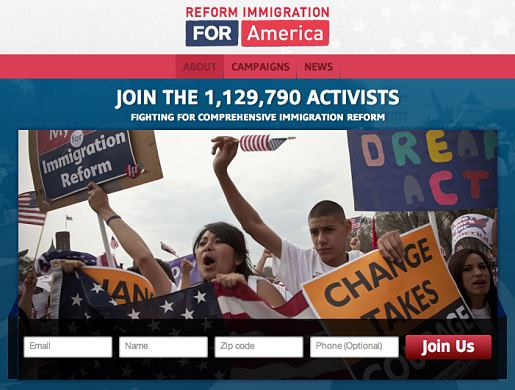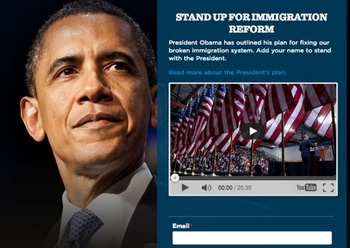In the middle of his college career at Arizona State University, Celso Mireles, an undocumented student, received some disheartening news. Under a new law called Proposition 300, his full academic scholarship, and the ability to pay in-state tuition, were going to disappear. Basically overnight, Mireles went from having to pay nothing for his education to being responsible for three times the amount paid by other Arizona residents. It was a major setback, forcing him to take a job in landscaping and as a farmhand in Colorado in order to pay for his degree in business management.

Mireles made it through to graduation and listened to his commencement speaker, President Obama, urge his graduating class to use their education to change the world.
Today, Mireles is the head of online organizing for United We Dream, one of the most recognizable immigration reform organizations in the country. He oversees the group’s email, social media and SMS efforts.
It’s the digital tools, both for United We Dream and the national immigration reform movement as a whole, that advocates like Mireles are counting on to play a major role of a grassroots effort they hope will turn the tide after years of defeat. As the battle gets underway, they are now ready to unleash a long-planned digital campaign.
Large-Scale Digital Organizing
The importance of digital tools in the fight for immigration reform emerged after advocates for reform found themselves unable to match the mobilization efforts of their opponents throughout the past decade.
“One of the lessons coming out of 2006 and 2007, where immigration reform had a chance but failed, was that talk radio really killed us on calls to Congress,” Jeff Parcher, spokesman for the Center for Community Change, an advocacy organization working on immigration reform, said in a phone interview. Parcher explained that the realization drove proponents of immigration reform to change the way they organize. They understood they needed to build an infrastructure with the ability to activate a large network quickly, and that digital was the way to do it.
The first step was to build a list. In 2008, a list generated by Reform Immigration for America, and held by the Center for Community Change, began collecting names of those who would take action on behalf of immigration reform. That list now stands at 1.1 million and, outside of a portion which is for phone-banking only, consists of people ready to be activated via email, SMS and social media.
The list will be used to urge volunteers to personally lobby Congress, make calls to stakeholders, and raise money, Parcher said. The digital element, Parcher said, will enable these actions to occur on a large scale.
“In our win we need scale and soul,” he said. “We need hundreds of thousands of people across a variety of demographic blocs in America to make their voices heard in the call for immigration.” The only way they can make that happen, Parcher explained, is through digital.
The Role of Mobile
While email will be a significant tool for immigration reform advocates, mobile, specifically SMS, is poised to play an outsized role. Parcher said he believes the SMS component of the list is the largest single action text messaging list in the country. It is particularly valuable, he said, because young Latinos and immigrants are used to interacting through their phones. Turning those messages into action, it seems, can be a fairly seamless activity. “We can directly reach them through text and patch them into calls to Congress or other political figures who we want to make ourselves heard to,” said Parcher of the aforementioned advocates.
Mireles and his team of young advocates at United We Dream see an important role for SMS outside their age range too. “One of the big strategies that we’re testing is how to reach that new constituency, our parents,” Mireles said. “Up until now we’ve been very social media driven and, to be more effective, we’re going to have to reach people where they are. For people like our parents, SMS is going to be the way.” Mireles, now 25, explained that he sees misinformation as a big problem for his parents’ generation, so his priority is first to educate and then to push them into action.
Spreading Stories With Social Media
Social media, unsurprisingly, will also be counted on as a powerful messaging tool by immigration reform advocates during the debate. There are specific communication plans in place to push out share-ready stories of undocumented immigrants in order to humanize the issue. Gordon Whitman, public policy director for the PICO National Network, explained in a phone interview that the hope is that these stories, with actual immigrants in them, will set the stage for a national conversation around immigration reform. “The most important thing that has to happen, as a precondition for a strong conversation and debate over immigration policy, is that we have to make sure we are introducing families in this country that have undocumented people in them,” said Whitman.
Whitman looks at the recent battle over the Dream Act as a model. While the Dream Act — which would have granted permanent residency to many young undocumented immigrants — failed to pass, one thing that came out of the fight was Deferred Action, or a suspension of deportation activity, for many of those who would have been covered under the act. Among immigration reform advocates, it is widely believed that a coming out campaign of these “Dreamers” was responsible, in large part, for the Deferred Action victory. Social media was critical in getting those stories to spread and is expected to play a large role in this debate as well. As Whitman put it, “The pathway to a better immigration system was through immigrants standing up, coming out of the shadows, telling their stories and then spreading those stories through social media.” That’s very different from some of the traditional, Washington, D.C.-based legislative campaigns, he said.
The Obama Campaign Steps In
On top of these efforts, the digital side of the newly reconstituted Obama campaign should be a force as well. After the president’s re-election, top campaign staff along with the campaign’s database moved over to the non-profit Organizing For America. The group was set up to support what advisers have said will be a key element in the president’s second term: an increased focus on building grassroots support for his initiatives. President Obama’s campaign manager, Jim Messina, has already emailed the campaign’s outreach list asking them to “stand with the president” on immigration reform. In the email, Messina wrote that the president’s goal was to establish a path to citizenship for the 11 million undocumented immigrants in the United States, a goal shared by every immigration reform advocate interviewed for this article.
On gun control, Messina has already emailed the list asking them to call their representatives in support of the president’s plan. So, it would not be surprising for Messina to make a similar request regarding immigration. The size of the Organizing For America’s list, said to be in the tens of millions, is large enough to generate a significant wave of activity should Messina make the request.
Sustained Pressure
Louis Desipio, a professor of political science at UC Irvine, expects the immigration reform battle to be a long one. “The nature of immigration reform, even if everyone is agreeing, which they are not, is that it’s going to take awhile,” he said. That lengthiness, according to Desipio, will make the sustained pressure and awareness generated by digital tools even more critical. “It takes an ongoing presence in Congress and in the communities that members of Congress represent to ensure that immigration reforms stays near the top of the agenda,” he said. “Immigration reform is an easy thing to put off if you’re not an immigrant.” Desipio said he expects the digital efforts to keep that pressure on.
Despite the long battle ahead, there is a sense among immigration reform advocates that this is their moment. After years of waiting, the climate looks ripe for the core of the legislation they want to be passed. Strong voting numbers and an Obama re-election have played in their favor, and they are hoping these digital tools, as part of a strong grassroots campaign, will help push the new law through. Already, there is movement. Both the executive branch and the Senate have released detailed plans, and the momentum is expected to intensify after the president’s State of The Union address.
Early this past week, Mireles opened up his snail mail to find another surprise: an approval of his Deferred Action application along with a temporary work card. In the midst of discussing his parents’ pride in his newly documented status, Mireles drifted into a recounting of a conversation he had with his mother where, sensing the answer might be more relevant now than anytime in the recent past, he asked what her own dreams and aspirations were. Mireles said his mother suggested factory work, something he said was simple yet essential. “It really impacted me,” he said. “Right now my goal is to make sure that my parents’ dreams come true. I think I owe them at least that and a lot more.”
Alex Kantrowitz covers the digital marketing side of politics for Forbes.com and PBS MediaShift. His writing has previously appeared in Fortune and the New York Times’ Local Blog. Follow Alex on Twitter at @Kantrowitz.


